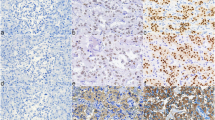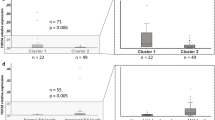Abstract
Background
One of the best known functions of the zinc-finger transcription factor Snail is to induce epithelial-mesenchymal transition (EMT). Twist, a target genes of Snail, is known to promote the development of distant metastases in mice. Increasing evidence suggests that EMT plays a pivotal role in tumor progression and metastatic spread.
Methods
Snail, Twist, and E-cadherin expression were assessed by immunohistochemistry and real-time quantitative reverse transcriptase–polymerase chain reaction in 12 malignant and 35 benign pheochromocytomas (PCC). Data were correlated with clinical characteristics and genetics.
Results
We found Snail expression in 13 (28%) of 47 primary PCC samples. Twist was expressed in 31 (66%) of 47 cases. Only one of 47 PCC showed E-cadherin expression. We observed Snail expression in 7 (58%) of 12 malignant PCC, whereas only 6 (17%) of 35 apparently benign PCC revealed Snail expression (P = 0.01). Furthermore, 11 (92%) of 12 malignant PCC, but only 20 (57%) of 35 benign PCC, revealed Twist expression (P = 0.03). Interestingly, all five metastases showed Snail and Twist expression. In normal adrenal medulla, Snail, Twist, and E-cadherin expression could not be detected.
Conclusions
We describe for the first time that EMT markers Snail and Twist are expressed in PCC and that their expression is associated with malignancy. Our study supports a role for EMT in the malignant transformation of PCC.




Similar content being viewed by others
References
Stenstrom G, Svardsudd K. Pheochromocytoma in Sweden, 1958–1981. An analysis of the National Cancer Registry Data. Acta Med Scand. 1986;220:225–32.
Beard CM, Sheps SG, Kurland LT, Carney JA, Lie JT. Occurrence of pheochromocytoma in Rochester, Minnesota, 1950 through 1979. Mayo Clin Proc. 1983;58:802–4.
Sinclair A, Isles CG, Brown I, Cameron H, Murray GD. Secondary hypertension in a blood pressure clinic. Arch Intern Med. 1987;147:1289–93.
Lo CY, Lam KY, Wat MS, Lam KS. Adrenal pheochromocytoma remains a frequently overlooked diagnosis. Am J Surg. 2000;179:212–5.
Neumann HP, Bausch B, McWhinney SR, et al. Germ-line mutations in nonsyndromic pheochromocytoma. N Engl J Med. 2002;346:1459–66.
Lehnert H, Mundschenk J, Hahn K. Malignant pheochromocytoma. Front Horm Res. 2004;31:155–62.
Eisenhofer G, Bornstein SR, Brouwers FM, et al. Malignant pheochromocytoma: current status and initiatives for future progress. Endocr Relat Cancer. 2004;11:423–36.
Zhou BP, Hung MC. Wnt, hedgehog and snail: sister pathways that control by GSK-3beta and beta-Trcp in the regulation of metastasis. Cell Cycle. 2005;4:772–6.
Cano A, Perez-Moreno MA, Rodrigo I, et al. The transcription factor snail controls epithelial-mesenchymal transitions by repressing E-cadherin expression. Nat Cell Biol. 2000;2:76–83.
Christofori G. New signals from the invasive front. Nature. 2006;441(7092):444–50.
Moody SE, Perez D, Pan TC, et al. The transcriptional repressor Snail promotes mammary tumor recurrence. Cancer Cell. 2005;8:197–209.
O’Rourke MP, Tam PP. Twist functions in mouse development. Int J Dev Biol. 2002;46:401–13.
Yang J, Mani SA, Donaher JL, et al. Twist, a master regulator of morphogenesis, plays an essential role in tumor metastasis. Cell. 2004;117:927–39.
Yang J, Mani SA, Weinberg RA. Exploring a new twist on tumor metastasis. Cancer Res. 2006;66:4549–52.
Fendrich VW, Farzad J, Ramaswamy E, et al. Snail and sonic hedgehog activation in neuroendocrine tumors of the ileum. Endocr Relat Cancer. 2007;14:865–74.
Waldmann J FG, Slater EP, Langer P, et al. Expression of the zinc-finger transcription factor Snail in adrenocortical carcinoma is associated with decreased survival. Br J Cancer. 2008;99:1900–7.
Esni F, Ghosh B, Biankin AV, et al. Notch inhibits Ptf1 function and acinar cell differentiation in developing mouse and zebrafish pancreas. Development. 2004;131:4213–24.
Livak KJ, Schmittgen TD. Analysis of relative gene expression data using real-time quantitative PCR and the 2(-Delta Delta C(T)) method. Methods. 2001;25:402–8.
Hammer GD, Parker KL, Schimmer BP. Minireview: transcriptional regulation of adrenocortical development. Endocrinology. 2005;146:1018–24.
Clouthier DE, Williams SC, Yanagisawa H, et al. Signaling pathways crucial for craniofacial development revealed by endothelin-A receptor–deficient mice. Dev Biol. 2000;217:10–24.
Murray SA, Carver EA, Gridley T. Generation of a Snail1 (Snai1) conditional null allele. Genesis. 2006;44:7–11.
Amar L, Servais A, Gimenez-Roqueplo AP, et al. Year of diagnosis, features at presentation, and risk of recurrence in patients with pheochromocytoma or secreting paraganglioma. J Clin Endocrinol Metab. 2005;90:2110–6.
Pacak K, Linehan WM, Eisenhofer G, Walther MM, Goldstein DS. Recent advances in genetics, diagnosis, localization, and treatment of pheochromocytoma. Ann Intern Med. 2001;134:315–29.
Barallo-Gimeno A, Nieto MA. The snail genes as inducers of cell movement and survival. Implications in development and cancer. Development. 2005;132:3151–61.
Selleck MA, Bronner-Fraser M. Origins of the avian neural crest: the role of neural plate-epidermal interactions. Development. 1995;121:525–38.
Liem KF Jr, Tremml G, Jessell TM. A role for the roof plate and its resident TGFbeta-related proteins in neuronal patterning in the dorsal spinal cord. Cell. 1997;91:127–38.
Newgreen DF, Erickson CA. The migration of neural crest cells. Int Rev Cytol. 1986;103:89–145.
Schlumberger M, Gicquel C, Lumbroso J, et al. Malignant pheochromocytoma: clinical, biological, histologic and therapeutic data in a series of 20 patients with distant metastases. J Endocrinol Invest. 1992;15:631–42.
Timmers HJ, Brouwers FM, Hermus AR, et al. Metastases but not cardiovascular mortality reduce life expectancy following surgical resection of apparently benign pheochromocytoma. Endocr Relat Cancer. 2008;15(4):1127–33.
Khorram-Manesh A, Ahlman H, Jansson S, Nilsson O. N-cadherin expression in adrenal tumors: upregulation in malignant pheochromocytoma and downregulation in adrenocortical carcinoma. Endocr Pathol. 2002;13:99–110.
Gupta D, Shidham V, Holden J, Layfield L. Prognostic value of immunohistochemical expression of topoisomerase alpha II, MIB-1, p53, E-cadherin, retinoblastoma gene protein product, and HER-2/neu in adrenal and extra-adrenal pheochromocytomas. Appl Immunohistochem Mol Morphol. 2000;8:267–74.
Ohta S, Lai EW, Pang AL, et al. Downregulation of metastasis suppressor genes in malignant pheochromocytoma. Int J Cancer. 2005;114:139–43.
Acknowledgment
G.F. was supported by a fellowship grant within the Postdoc-Programm of the German Academic Exchange Service (DAAD). V.F. was supported by a research grant of the University Medical Center Giessen and Marburg.
Author information
Authors and Affiliations
Corresponding author
Rights and permissions
About this article
Cite this article
Waldmann, J., Slater, E.P., Langer, P. et al. Expression of the Transcription Factor Snail and Its Target Gene Twist Are Associated with Malignancy in Pheochromocytomas. Ann Surg Oncol 16, 1997–2005 (2009). https://doi.org/10.1245/s10434-009-0480-y
Received:
Revised:
Accepted:
Published:
Issue Date:
DOI: https://doi.org/10.1245/s10434-009-0480-y




